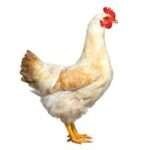Imagine a chicken that’s not only a feathered beauty but also a prolific egg layer. A chicken that’s both friendly and docile, perfect for families and small-scale farms. Meet the Black Copper Maran, a breed that’s captured the hearts of chicken keepers and gourmet chefs alike. In this guide, we’ll explore the world of Black Copper Maran chickens and help you decide if they’re the right addition to your backyard flock.
Characteristics of Black Copper Maran Chickens
The Black Copper Maran is renowned for its striking appearance. These chickens are of medium size with beautiful feathering. Their feathers shimmer with a deep, dark iridescence that’s both elegant and captivating. The defining characteristic of this breed is the black copper feathers around their neck and back. This is where they get their name.
In addition to their captivating aesthetics, Black Copper Marans have a reputation for having charming and docile personalities. This makes them great choices for families and individuals looking for friendly backyard birds. They’re known to be gentle and easy to handle, which can be especially appealing if you have children who want to get involved in chicken keeping.
Egg Laying Capabilities
One of the most impressive qualities of Black Copper Marans is their egg-laying prowess. Hens from this breed are known for producing a significant number of eggs throughout the year. While their laying rate may vary somewhat with age, they consistently deliver more than many other breeds. The eggs are often large and beautifully colored, making them not only a delight to collect but also a unique addition to your kitchen.
These chickens are also relatively hardy and adapt well to different climates. They can handle both the heat of summer and the cold of winter, making them suitable for a variety of geographic locations. Their foraging skills are excellent, which means they can find a good portion of their own food if allowed to free-range.
The gentle nature, striking appearance, and egg-laying abilities of Black Copper Marans all contribute to their popularity among chicken keepers. However, it’s essential to consider your specific goals when deciding if this breed is right for your backyard farm.
Black Copper Maran Eggs: Color, Size, and Uniqueness
If you’re thinking about adding Black Copper Marans to your backyard flock, it’s likely because you’ve heard about their incredible eggs. These eggs are so unique that they’ve earned a special place in the culinary world, highly sought after by chefs, bakers, and food enthusiasts.
Egg Color: Chocolate-Brown Delight
What truly sets Black Copper Maran eggs apart from the rest is their eggshell color. These eggs are renowned for their stunning deep chocolate-brown hue. The shade is so rich that it’s often described as “chocolate” or “cocoa” brown. This unique coloration is caused by the genetics of the breed and is consistent in Black Copper Maran hens.
The remarkable thing about Maran eggs is that the color isn’t limited to the shell. Even the egg yolk tends to be more vibrant in Maran eggs, with a deep yellow or orange color. This, in part, is due to the presence of certain pigments in the chicken’s diet, such as xanthophylls from green plants.
Because of their striking appearance, Black Copper Maran eggs are highly sought after for specialty and gourmet dishes. Whether you’re baking a batch of rich chocolate desserts or simply want your fried or scrambled eggs to have a bit of extra pizzazz, Maran eggs deliver.
Egg Size: Large and In Charge
Beyond their unique color, Black Copper Maran eggs are known for their size. These eggs are often larger than those of many commercial breeds, making them a practical choice for egg-focused chicken keepers.
The typical Maran egg is considered large, which means it’s not only visually appealing but also quite satisfying when you crack it open. This can be especially important for households that rely on eggs as a primary protein source or for baking needs.
For comparison, let’s take the popular commercial breed, the ISA Brown, which is known for its egg-laying abilities. While ISA Browns are excellent layers, their eggs are typically medium-sized. So, when you’re considering egg production versus egg size, Black Copper Maran eggs can offer a unique advantage.
Market Demand and Uniqueness
The allure of Black Copper Maran eggs extends beyond your own kitchen. These eggs are highly sought after in specialty markets and restaurants. The rich color and large size make them stand out, which can be a selling point for those looking to earn an income from their backyard flock.
While the eggs themselves are unique, it’s also the breed’s reputation for consistent laying that contributes to their desirability. If you’re looking to sell eggs at local markets or to upscale restaurants, Black Copper Marans can be a lucrative choice.
In the next section, we’ll delve into the dual-purpose nature of Black Copper Marans, exploring their potential for meat production. We’ll also compare this breed to commercial egg layers, helping you make an informed decision about adding them to your backyard farm.
Use of Black Copper Maran Chickens: Eggs or Meat?
One of the significant advantages of Black Copper Maran chickens is their dual-purpose nature. Not only are they renowned for their egg-laying abilities, but they’re also suitable for meat production. This versatility is a key consideration for backyard chicken keepers who aim to maximize their flock’s potential.
Egg Production: A Reliable Source of Eggs
Black Copper Marans have gained their reputation as outstanding egg layers for a good reason. These hens consistently produce a high number of eggs throughout the year. While their laying rate can vary somewhat with age, they remain productive layers even as they grow older.
Their eggs are not only numerous but also uniquely colored, with that coveted deep chocolate-brown hue. For those who appreciate eggs with a bit of extra flair, Maran eggs are a real treat. Whether you’re sharing them with friends and family or selling them at local markets, these distinctive eggs are sure to draw attention.
Meat Production: A Delicious Option
While Black Copper Marans are celebrated for their eggs, they shouldn’t be overlooked as a source of flavorful and tender meat. The meat of Maran chickens is highly regarded for its rich taste and texture, making it a preferred choice for gourmet dishes.
Compared to commercial meat breeds like the Cornish Cross, Black Copper Maran chickens take longer to reach their full size. However, their extended growth period contributes to the development of deliciously marbled meat. For those who appreciate high-quality chicken on their dinner table, Black Copper Maran meat is a real delicacy.
Comparing to Commercial Egg Layers
If you’re pondering whether to choose Black Copper Marans or commercial egg layers like ISA Browns, there are some essential points to consider.
ISA Browns, for example, are renowned for their exceptional egg-laying capabilities. They’re prolific layers of large, brown eggs and are often preferred by those who want a consistent source of eggs. However, while they lay more eggs than the average Black Copper Maran, their eggs lack the deep brown coloration that makes Maran eggs so unique.
Black Copper Marans may not match the ISA Browns in terms of sheer volume, but they offer distinct advantages in other areas. Their eggs are not only visually appealing but also larger in size, making them more satisfying for a variety of culinary uses. Additionally, their dual-purpose nature means you can enjoy both their eggs and meat.
In the final section of this guide, we’ll explore the suitability of Black Copper Maran chickens for a backyard farm. We’ll discuss considerations such as space requirements, ease of care, and potential challenges. This will help you determine whether these captivating chickens are the right choice for your specific needs.
Backyard Farm Suitability and Considerations
Now that we’ve discussed the remarkable qualities of Black Copper Maran chickens, it’s time to address their suitability for a backyard farm. These considerations can help you determine whether these captivating chickens are the right choice for your specific needs.
Space Requirements:
Black Copper Maran chickens, like many other backyard breeds, require adequate space to thrive. Each chicken needs enough room to move about comfortably, both inside the coop and in the outdoor run or free-range area. A general rule of thumb is to provide at least 2-3 square feet of indoor space and 8-10 square feet of outdoor space per chicken. If you plan to have a sizable flock, ensure your coop and run can accommodate them.
Ease of Care:
One of the significant advantages of Black Copper Marans is their ease of care. They are hardy, adaptable birds that can handle different weather conditions. While they enjoy free-ranging, they can also do well in confined spaces, making them ideal for smaller backyard farms.
In terms of maintenance, Black Copper Marans require the same basic care as any other chicken breed. They need fresh water daily, quality poultry feed, and a clean living environment. Regular health checks and occasional deworming are also essential for their well-being.
Potential Challenges:
Like any breed, Black Copper Marans come with their own set of challenges. The main potential drawback is their egg-laying rate. While they lay consistently and produce uniquely colored eggs, they may not match the sheer volume of commercial egg layers like ISA Browns. If you’re primarily interested in egg production and high numbers, a different breed might be more suitable.
Another consideration is the time it takes for Black Copper Marans to reach their full size. If you’re looking for rapid meat production, breeds specifically bred for that purpose might be more appropriate. However, keep in mind that the delicious flavor and texture of Maran meat can make the wait worthwhile for those who appreciate high-quality chicken.
In conclusion, Black Copper Maran chickens are a captivating and versatile addition to any backyard farm. Their striking appearance, unique eggs, and dual-purpose nature make them a top choice for chicken enthusiasts who value both egg and meat production. When considering these charming chickens for your flock, assess your specific goals and preferences, taking into account factors such as space, ease of care, and your focus on eggs or meat. With proper care and attention, Black Copper Marans can bring joy and benefits to your backyard farm for years to come.
Frequently Asked Questions About Black Copper Maran Chickens
- Are Black Copper Marans suitable for beginners in chicken keeping?
- Yes, they are an excellent choice for beginners due to their docile nature and ease of care.
- What sets Black Copper Maran eggs apart from other breeds?
- Their eggs are known for their deep chocolate-brown color and large size, making them unique and desirable.
- How does the meat of Black Copper Marans compare to commercial meat breeds?
- While they take longer to reach full size, the meat is highly regarded for its rich taste and texture.
- Can I raise Black Copper Marans in a small backyard or limited space?
- Yes, they adapt well to confined spaces, but providing adequate room for your chickens to roam is essential.
- What’s the typical lifespan of Black Copper Maran chickens?
- With proper care, they can live for 5 to 8 years or more.
- Do Black Copper Marans require any special dietary considerations?
- They have standard dietary needs and thrive on a balanced poultry feed.
- Are Black Copper Maran eggs in high demand, and can I sell them for profit?
- Yes, they’re sought after in specialty markets and restaurants, making them a potentially profitable choice.
- Are Black Copper Marans prone to any specific health issues or diseases?
- They share common chicken health concerns, so regular health checks and proper care are essential.
- Can I keep Black Copper Marans alongside other chicken breeds in the same coop?
- Yes, they generally get along well with other breeds, making it possible to maintain a mixed flock.






